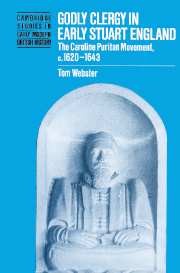Book contents
- Frontmatter
- Contents
- Acknowledgments
- List of abbreviations
- Introduction
- Part I Society, clerical conference and the Church of England
- Part II The godly ministry: piety and practice
- Part III ‘These uncomfortable times’: conformity and the godly ministers 1628–1638
- 7 Thomas Hooker and the conformity debate
- 8 Trajectories of response to Laudianism
- 9 The ecclesiastical courts and the Essex visitation of 1631
- 10 Juxon, Wren and the implementation of Laudianism
- 11 The diocese of Peterborough: a see of conflict
- 12 The metropolitical visitation of Essex and the strategies of evasion
- Part IV ‘These Dangerous Times’: the Puritan Diaspora 1631–1643
- Index
- Cambridge Studies in Early Modern History
9 - The ecclesiastical courts and the Essex visitation of 1631
Published online by Cambridge University Press: 04 November 2009
- Frontmatter
- Contents
- Acknowledgments
- List of abbreviations
- Introduction
- Part I Society, clerical conference and the Church of England
- Part II The godly ministry: piety and practice
- Part III ‘These uncomfortable times’: conformity and the godly ministers 1628–1638
- 7 Thomas Hooker and the conformity debate
- 8 Trajectories of response to Laudianism
- 9 The ecclesiastical courts and the Essex visitation of 1631
- 10 Juxon, Wren and the implementation of Laudianism
- 11 The diocese of Peterborough: a see of conflict
- 12 The metropolitical visitation of Essex and the strategies of evasion
- Part IV ‘These Dangerous Times’: the Puritan Diaspora 1631–1643
- Index
- Cambridge Studies in Early Modern History
Summary
The lowest level of ministerial discipline in Essex was the archidiaconal court. Three archdeacons had jurisdiction in the county: the largest archdeaconry, which took its name from the county, included the deaneries of Barking, Barnstaple, Chafford, Chelmsford, Dengie and Ongar, taking in the southern and central parts of the county; the north-east fell under the Archdeacon of Colchester, covering the deaneries of Tendring, Colchester, Lexden and Witham, and also the north-westerly deaneries of Newport and Sampford; between these areas, part of the archdeaconry of Middlesex took in Harlow, Dunmow and Hedingham deaneries. Small areas fell under other authorities as the fossilised remnants of pre-Reformation jurisdictions: the tiny deanery of Bocking was directly answerable to Canterbury; part of the civil hundred of Tendring was a Peculiar of the Earl Rivers, and the lands formerly governed by Waltham Abbey retained the right to hold their own court under the jurisdiction of the bishop of London's Commissary in London, Barking and Middlesex. The Liberty of Havering, Writtle and Roxwell constituted a Peculiar of New College, Oxford. For visitation purposes the archdeaconry of Colchester split into three circuits: one for the separate area in the north-west, with the court held at Walden or Henham; a second for the Colchester and Tendring deaneries, with the court at Colchester; and the court for Lexden and Witham at Kelvedon. The archdeaconry of Essex, despite its size, was covered by only two circuits: Barking, Ongar and Chafford were governed by a court sitting at Romford; Chelmsford, Rochford, Barnstaple and Dengie deaneries reported to a court which usually sat at Great Baddow or occasionally Chelmsford.
- Type
- Chapter
- Information
- Godly Clergy in Early Stuart EnglandThe Caroline Puritan Movement, c.1620–1643, pp. 180 - 203Publisher: Cambridge University PressPrint publication year: 1997
- 1
- Cited by



